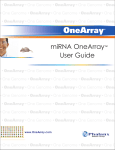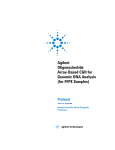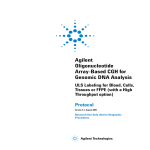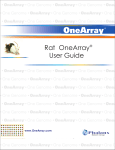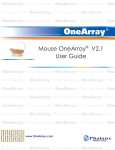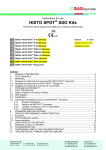Download User Guide - ULS Labeling of microRNA
Transcript
User Guide - ULS Labeling of microRNA Version 1.0 Product: Catalog number: Lot number: Unit Size: Storage conditions: (February 2009) ULS™ microRNA Labeling Kit EA-036, EA-037 and EA-038 See label on package 10 dual color labeling reactions or 20 single color labeling reactions See below IMPORTANT NOTE: This user guide contains minimal information to provide experienced users with a short protocol to use at the bench! A more detailed, full manual can be downloaded from our website: http://www.kreatech.com I. RNA quality For total RNA isolation we recommend to use Trizol (Invitrogen) extraction followed by TM precipitation or microRNA enrichment using any of the following kits: miRNeasy procedure TM TM (QIAGEN), mirVana miRNA Isolation procedure (Ambion/Applied Biosystems), miRACLE miRNA isolation kit (Stratagene). Regardless what source of RNA is being used, the following quality criteria should be met: For all RNAs OD260/OD280 should be >1.90 OD260/OD230 should be >2.10 Be aware that some components in silica based purification systems inhibit the ULS labeling reaction. This can be prevented by a final wash step using 80% ethanol (PA) before elution, followed by elution using ultrapure water instead of elution buffer II. ULS Labeling of total RNA or microRNA enriched RNA Note: the procedure described below is assuming the need to hybridize 1 µg of total RNA or microRNA enriched RNA per sample on a microarray. In case your application needs more or less sample to be hybridized, you can scale up or down accordingly: use a ratio of exactly 1.0 µL of ULS per 1.0 µg of RNA. The optimal RNA concentration for ULS labeling is ≥50 ng/µL. If less than 1 µg RNA is available, use lower labeling volumes in order to aim for a RNA concentration of 50 ng/µL (e.g. if only 250 ng RNA is available the optimal labeling volume is 5 µL) 1. Briefly spin all required reagents to drive the contents off the walls and lid. 2. Pre-heat a waterbath OR thermocycler at 85°C. 3. Add RNA and ultrapure water to the tube to a total volume of 17.0 µL 4. Add 2.0 µl of 10 x Labeling Solution to obtain a 1 x Labeling Solution. 5. Add 1.0 µl of Cy3-ULS or Cy5-ULS. 6. Incubate sample for 15 minutes at 85°C. 7. Place samples directly on ice and spin down to drive the contents off the walls and lid. 8. Continue with the KREApure purification to remove non- reacted ULS dyes (section III). Page 1 of 2 Example of Cy-ULS labeling of 1 µg of total RNA or microRNA enriched RNA Labeling mixture RNA Cy-ULS 10 x labeling solution Ultrapure water Total volume x µL (= 1.0 µg) 1.0 µL 2.0 µL 17 - x µL 20 µL NOTE: Be aware that the ratio µL ULS compound vs. µg RNA is always exactly 1 : 1. III. Removal of non-reacted ULS dyes using KREApure columns Optional: If lower labeling volumes are used adjust volume to 20 µL using ultrapure water. 9. Add ULS-labeled RNA onto the center of the column bed. 10. Centrifuge column for 1 minute at max speed using a tabletop microcentrifuge. 11. Flow-through contains the purified, labeled RNA. 12. Determine the degree of labeling (DoL) by measuring absorbance at 260nm and 550nm (for Cy3-ULS) or 650nm (for Cy5-ULS) 13. Calculate the Density of Labeling (DoL) value using the interactive calculator on our website (www.kreatech.com) 14. Store the sample (- 20°C) or proceed with the hybridization procedure. 1. Resuspend column material by vortexing 2. Loosen cap ¼ turn and snap off the bottom closure 3. Place the column in a 2 mL collection tube 4. Pre-spin the column for 1 minute at 20,800 x g (i.e. maximum speed of a typical table-top microcentrifuge) 5. Discard flow-through and column cap, but re-use collection tube 6. Add 300 µL ultrapure water to the column and centrifuge for 1 min at 20,800 x g 7. Discard collection tube and flow through 8. Place column in a nuclease-free 1.5 mL microcentrifuge tube (not provided) IV. Preparation of labeled total RNA using KREAblock solution (optional) forhybridization 3. 1. 2. For dual color assays, pool the labeled samples. Concentrate (using a concentrator) to nearly dryness. 4. This product is intended for RESEARCH USE ONLY. IT IS NOT INTENDED FOR DIAGNOSTIC APPLICATIONS and/or COMMERCIAL PURPOSES. Limited Product Warranty – Patent Disclaimer This warranty limits our liability to replacement of this product. No other warranties of any kind express or implied, including without limitation, implied warranties or fitness for a particular purpose, are provided by KREATECH. KREATECH shall have no liability for any direct, indirect, consequential, or incidental damages arising out of use, or the inability to use this product. This product or the use of this product is covered by US patents 5,580,990; 5,714,327; 5,985,566; 6,133,038; 6,338,943 and several foreign patents owned by KREATECH Biotechnology B.V, KREATECH is a trade name of KREATECH Biotechnology B.V., ULS™, KREApure™, and KREAblock™ are trademarks of KREATECH Biotechnology B.V. KREATECH’s Universal Linkage System are subject to patent protection. Cy™3 and Cy™5 are trademarks of Amersham Bioscience, part of GE healthcare. After concentration, dissolve the labeled material in ¼ volume of ultrapure water and add ¼ volume KREAblock (optional; otherwise add another ¼ volume of ultrapure water). Add ½ volume of 2 x Hybridization buffer. KREATECH Diagnostics Vlierweg 20 1032 LG Amsterdam, The Netherlands Telephone: +31 20 691 91 81 Fax: +31 20 696 35 31 e-mail: [email protected] website: www.kreatech.com Distributed by: Phalanx Biotech Group 1400 Page Mill Road, Building B, Palo Alto, CA, 94304, USA. Tel: 650-320-8669 Fax: 650-320-8488 Email: [email protected] Website: www.OneArray.com Page 2 of 2



